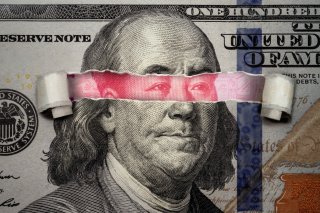A Lesson for America in China’s Economic Plight
The kind of industrial policies promoted by Bidenomics raises the risk of going down the path that China has taken.
The difference has only expanded since. Even with all of Washington’s spending on Covid relief, debt—federal, local, state, and private—in the United States amounted to some $57 trillion at the close of last year, about 2.2 times the nation’s nominal GDP. Comparable debt levels in China amounted to the equivalent of over $51 trillion, almost three times the size of China’s nominal GDP. In other words, the accumulated waste from mistaken projects in China is a third higher than in the United States, a difference that is that much more striking given that the United States has a much older developed economy than China and so has had a longer time to accumulate planning errors and debt. And, according to the Beijing-backed National Institute for Finance and Development, local authorities alone in China are scheduled this year to issue the equivalent of $570 billion in new debt to help finance Beijing’s latest spending on infrastructure.
The kind of industrial policies promoted by Bidenomics raises the risk of going down the path that China has taken. Of course, the planners may get lucky. That may be true of China’s planners as well. Not surprisingly, planners in both places have focused on the same future frequently describe in today’s headlines—advanced computer chips, artificial intelligence, electric vehicles, battery technology, and its basic inputs. If these become the future, it is just as likely that new technology will supersede them. That is exactly what happened in the 1980s when the widespread use of Intel’s microprocessor rendered wasteful Japanese plans to corner the market in simpler chips. Alternatively, planned development in both China and the United States could create a global glut of these products. Or the buying public—whether in the United States or China or elsewhere—may turn out to have less interest in these projects than the planners do. In any of these events, all the effort and resources marshaled by these planners will fail to have the anticipated economic payoff, while in the meantime all that effort will have crowded out alternative projects that otherwise might have hit on a future need.
Except in those rare instances when the future is obvious, as when China was so horribly underdeveloped, all economic plans—whether made by a government or by a private company—are a guessing game. Sometimes they work out, often not. Because central planning unavoidably only focuses on a limited number of projects, almost always drawn from the prevailing headlines of the day, they can easily miss. When they do, economies suffer huge waste and become saddled with debt that the failed project cannot support, a fact to which China’s huge debt overhang testifies. While burdening economies in this way, the central plans divert resources from a diversity of effort that has a better chance of finding that elusive future need. That is what modern China suffers today and where Bidenomics threatens to take America.
Milton Ezrati is a contributing editor at The National Interest, an affiliate of the Center for the Study of Human Capital at the University at Buffalo (SUNY), and chief economist for Vested, the New York-based communications firm. His latest books are Thirty Tomorrows: The Next Three Decades of Globalization, Demographics, and How We Will Live and Bite-Sized Investing.
Image: Shutterstock.

